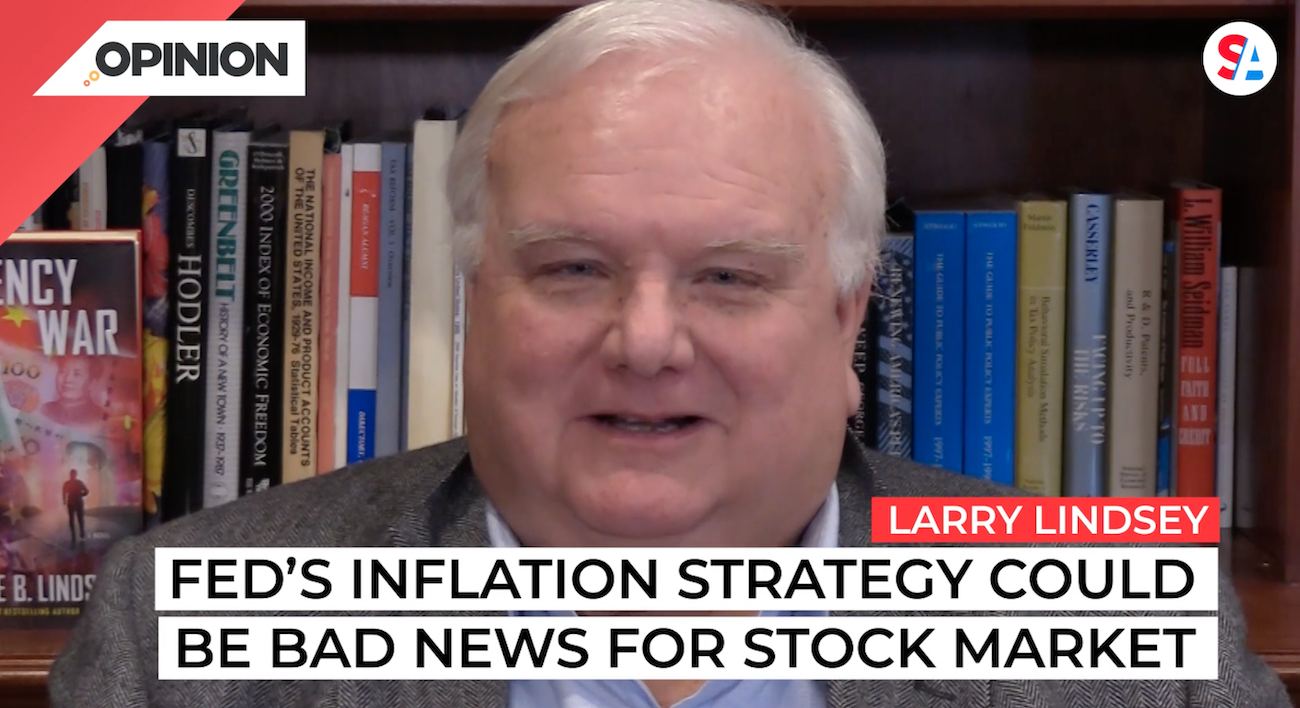
Commentary
-
Our commentary partners will help you reach your own conclusions on complex topics.
Happy new year, everyone. It’s not my purpose or that of Straight Arrow News to give you investment advice. And this isn’t; this is just a look at what’s happening and what’s happened in the past at times like this, and you make up your own mind what you wanna do about it.
So the first day of the new year got off with a bang in terms of markets. And then things fell apart. Over the next four days, the first week market was down about 3.7% in value. That’s a big loss. That’s stocks; bond yields went up. They went up about a quarter of a percentage point. That may not sound like a lot, but it’s always a lot in just one week. And it’s particularly a lot when you’re starting at one and a quarter to one and a half percent; that extra quarter point is worth a whole lot.
Well, why did that happen?
First weeks of the year, generally pretty good. And this one was terrible. And the answer is that the minutes from the last Federal Reserve Board meeting, that took place in mid-December were released and it seemed like the fed is signaling that it’s going to beginning to get quite serious about fighting inflation.
The inflation news has been bad. The employment report was pretty good, but wages kept going up and wages are putting a floor under prices. So how is the Fed going to attack our inflation problem? The first thing they’re gonna do is they’re going to stop adding more money to the system.
Now what the Fed does when it adds money, is it goes out and buys government bonds with the money that it creates. The bond is the asset behind the money. And theoretically, this can go into reverse where they can sell the bond, take the money back and you know, it disappears.
We’ve had an enormous explosion in just the last two years, over two years. Just before COVID started. We had printed or the Fed had on its balance is the way to say, four point one 5 trillion trillion dollars, 4.15 trillion with a T, dollars. That’s quite a bit. It’s, you know, on the order of a little more than a thousand dollars excuse me for every man, woman and child in America, about 13 hundred dollars for every man woman in child in America.
But then just in those two years, years, that amount increased by 111%. We more than doubled the amount of money in circulation, in the space of what was a little bit less than two years. Well guess what happens when you push that much more money out the door? You’re gonna put upward pressure on inflation. And indeed we did. Um, another way to think about it is to look back to when we started this process of adding money, which was after the great recession.
Back in 2008, we had just $900 billion in terms of money out there in circulation. So we have almost 10 times as much money circulating out there…on the fed balance sheet, as we had in 2008, which really wasn’t that far ago. Ten times as much.
Well, the second thing the Fed is going to do is it’s going to raise interest rates. Now, most people think that they’re probably going to raise interest rates three times a year, excuse me, in 2022. Maybe they’ll do four. Well, right now interest rates are only a quarter of a percentage point. So if they raise them three times, by the end of the year interest the fed charges to banks to borrow, we’ll be all the way up to 1% and maybe one and a quarter percent. Well, just think of it this way. If you could borrow it 1%, simply go out and buy canned goods, which are gonna go up five or 6% this year, you’re gonna make money. So 1% fed funds rate is just not gonna do anything for inflation. In fact, the other thing you’re more likely to do is go out and buy stocks.
If you were able to buy stocks by borrowing at say 1% or even 3% last year, you ended up with stocks going up almost 25%. Again, you would be foolish not to go out and borrow well, as long as you’re borrowing, there’s more money going out the system and things are going to go up. You have to get interest rates up close to the rate of inflation. Before you’re able to begin to discourage people from borrowing and spending money. Then the Fed announced, and this surprised everybody, that they might not only stop adding money, they may start shrinking it. Well, if they’re gonna shrink the amount of money out there, that means there’s gonna be more less money to spend or less money to buy stocks with. And not only that, the Fed started this buying bonds to force the rest of us to take riskier investments, cuz they’d bought up all the bonds.
Well, if you’re gonna put that in reverse, we’re gonna have to buy less risky investments, which means sell our high-flying stocks and buy bonds instead. Result is there’s probably going to be some real pressure on stock prices and everything else if the Fed follows through with this plan.
Well, the other problem we have is that stocks are historically very, very high. For example, we now just when we compare where stocks are now to where they were, we’ve had a 383% increase in stocks and we’ve only had a 56% increase in GDP. What that means is that people are now paying for stocks about three times as much for every dollar of output as they were just a few years ago. Well, you’re paying a lot more for the same amount of output. That means you’re probably paying too much. Well, you can guess…what’s going to happen.
And by the way, just to put this in even more perspective. Many of you may remember the so-called dot com bubble in the late nineties. Believe it or not, stocks relative to GDP are now twice what they were at the top of the.com bubble that should give some indication of how much risk there is. The only question is will the Fed follow through on what it says it’s going to do?
We’re not here to give you investment advice. We’re here just to give you the facts and a little bit of history and you should take those into consideration when deciding what to do with your portfolio.
-
Election 2024 will boil down to the Great Lakes states
Pollsters and pundits have been engaged in a long debate about how Biden or Trump might win the 2024 election, with much of their focus spent on the “swing state” electoral battlegrounds. While the winners of Alabama or California may be obvious, for instance, who wins Pennsylvania is a more difficult question. Watch the above… -
Why the Fed should consider Theory of Reflexivity when fixing policy
The Theory of Reflexivity, often used in the context of economics and financial markets, implies that investors don’t base their decisions on reality but on their perceptions of reality. This creates a feedback loop where investors’ perceptions influence economic fundamentals, which in turn alter investor perceptions. Watch the above video as Straight Arrow News contributor… -
Federal Reserve surpassed its own wildest expectations
On May 14, the U.S. Bureau of Labor Statistics released the most current producer price index (PPI) report, which showed an increase of 0.5% month-over-month in April. After the report’s release, U.S. Federal Reserve chairman Jerome “Jay” Powell said that while he believes the current policy rate is restrictive by many measures, the Fed needs… -
Polls give slight advantage to Trump in Electoral College
With the U.S. general election only six months away, leading candidates President Joe Biden and former President Donald Trump appear to be engaged in a very close contest. In their 2020 race, the winner of the Electoral College was ultimately determined by a relative handful of voters in just a few swing states, even though… -
College sports is big money but not everyone benefits
March Madness has wrapped up and Caitlin Clark has emerged as a household name as well as a wealthy student athlete. Earning over $3 million throughout her college career, her success stands in stark contrast to the previous notion that collegiate athletes shouldn’t earn anything beyond their scholarship. Straight Arrow News contributor Larry Lindsey examines…
Latest Opinions
-
 Getty Images
Getty Images
Andrew Cuomo announces NYC Mayor candidacy
-
 Getty Images
Getty Images
US troops bolster border security to curb illegal crossings
-
 Getty Images
Getty Images
Zelenskyy meets with British prime minster following tense Trump meeting
-
 Getty Images
Getty Images
Trump admin. asks federal workers to detail weekly accomplishments, again
-
 Getty Images
Getty Images
Military members with gender dysphoria to be processed for separation: DOD
Popular Opinions
-
In addition to the facts, we believe it’s vital to hear perspectives from all sides of the political spectrum.






